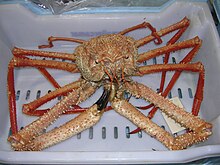Homoloidea: Difference between revisions
Content deleted Content added
m Open access bot: pmc updated in citation with #oabot. |
Citation bot (talk | contribs) Added pmid. Removed proxy/dead URL that duplicated identifier. Removed parameters. | Use this bot. Report bugs. | Suggested by Abductive | Category:Arthropod superfamilies | #UCB_Category 94/95 |
||
| Line 13: | Line 13: | ||
}} |
}} |
||
'''Homoloidea''' is a [[superfamily (taxonomy)|superfamily]] of [[dromiacea]]n [[crab]]s. Homoloidea belongs the group [[Dromiacea]], taxonomically ranked as a [[section (zoology)|section]], and is the [[sister group]] to [[Dromioidea]]. [[Dromiacea]] is the most [[basal (phylogenetics)|basal]] grouping of [[Brachyura]] crabs, and likely diverged from the rest of [[Brachyura]] around the [[Late Triassic]] or [[Early Jurassic]].<ref name="Ling">{{cite journal |title=Evolutionary History of True Crabs (Crustacea: Decapoda: Brachyura) and the Origin of Freshwater Crabs |author1=Ling Ming Tsang |author2=Christoph D. Schubart |author3=Shane T. Ahyong |author4=Joelle C.Y. Lai |author5=Eugene Y.C. Au |author6=Tin-Yam Chan |author7=Peter K.L. Ng |author8=Ka Hou Chu |journal=[[Molecular Biology and Evolution]] |publisher=[[Oxford University Press ]]|volume=31 |issue=5 |year=2014 |pages=1173–1187 |doi=10.1093/molbev/msu068 |doi-access=free}}</ref><ref name="Wolfe2019">{{cite journal |last1=Wolfe |first1=Joanna M. |last2=Breinholt |first2=Jesse W. |last3=Crandall |first3=Keith A. |last4=Lemmon |first4=Alan R. |last5=Lemmon |first5=Emily Moriarty |last6=Timm |first6=Laura E. |last7=Siddall |first7=Mark E. |last8=Bracken-Grissom |first8=Heather D. |
'''Homoloidea''' is a [[superfamily (taxonomy)|superfamily]] of [[dromiacea]]n [[crab]]s. Homoloidea belongs the group [[Dromiacea]], taxonomically ranked as a [[section (zoology)|section]], and is the [[sister group]] to [[Dromioidea]]. [[Dromiacea]] is the most [[basal (phylogenetics)|basal]] grouping of [[Brachyura]] crabs, and likely diverged from the rest of [[Brachyura]] around the [[Late Triassic]] or [[Early Jurassic]].<ref name="Ling">{{cite journal |title=Evolutionary History of True Crabs (Crustacea: Decapoda: Brachyura) and the Origin of Freshwater Crabs |author1=Ling Ming Tsang |author2=Christoph D. Schubart |author3=Shane T. Ahyong |author4=Joelle C.Y. Lai |author5=Eugene Y.C. Au |author6=Tin-Yam Chan |author7=Peter K.L. Ng |author8=Ka Hou Chu |journal=[[Molecular Biology and Evolution]] |publisher=[[Oxford University Press ]]|volume=31 |issue=5 |year=2014 |pages=1173–1187 |doi=10.1093/molbev/msu068 |doi-access=free|pmid=24520090 }}</ref><ref name="Wolfe2019">{{cite journal |last1=Wolfe |first1=Joanna M. |last2=Breinholt |first2=Jesse W. |last3=Crandall |first3=Keith A. |last4=Lemmon |first4=Alan R. |last5=Lemmon |first5=Emily Moriarty |last6=Timm |first6=Laura E. |last7=Siddall |first7=Mark E. |last8=Bracken-Grissom |first8=Heather D. |title=A phylogenomic framework, evolutionary timeline and genomic resources for comparative studies of decapod crustaceans |journal=Proceedings of the Royal Society B | date=24 April 2019 |volume=286 |issue=1901 |doi=10.1098/rspb.2019.0079 |pmid=31014217 |doi-access=free |pmc=6501934 }}</ref> The close relation between Homoloidea and [[Dromioidea]] is primarily established through [[ultrastructure|ultrastructural]] characteristics of the [[sperm]].<ref name="M&D">{{cite book |url=http://atiniui.nhm.org/pdfs/3839/3839.pdf |title=An Updated Classification of the Recent Crustacea |author=Joel W. Martin & George E. Davis |year=2001 |pages=1–132 |publisher=[[Natural History Museum of Los Angeles County]] }}</ref> |
||
The below [[cladogram]] shows Homoloidea's placement within [[Dromiacea]]:<ref name="Ling"/> |
The below [[cladogram]] shows Homoloidea's placement within [[Dromiacea]]:<ref name="Ling"/> |
||
Latest revision as of 21:19, 16 January 2024
| Homoloidea Temporal range:
| |
|---|---|

| |
| Paromola cuvieri | |
| Scientific classification | |
| Domain: | Eukaryota |
| Kingdom: | Animalia |
| Phylum: | Arthropoda |
| Class: | Malacostraca |
| Order: | Decapoda |
| Suborder: | Pleocyemata |
| Infraorder: | Brachyura |
| Section: | Dromiacea |
| Superfamily: | Homoloidea De Haan, 1839 |
| Families | |
Homoloidea is a superfamily of dromiacean crabs. Homoloidea belongs the group Dromiacea, taxonomically ranked as a section, and is the sister group to Dromioidea. Dromiacea is the most basal grouping of Brachyura crabs, and likely diverged from the rest of Brachyura around the Late Triassic or Early Jurassic.[1][2] The close relation between Homoloidea and Dromioidea is primarily established through ultrastructural characteristics of the sperm.[3]
The below cladogram shows Homoloidea's placement within Dromiacea:[1]
| Dromiacea |
| ||||||||||||||||||
Recent studies have found that the Homoloidea family Homolidae is paraphyletic with respect to Latreilliidae.[1]
See also[edit]
References[edit]
- ^ a b c Ling Ming Tsang; Christoph D. Schubart; Shane T. Ahyong; Joelle C.Y. Lai; Eugene Y.C. Au; Tin-Yam Chan; Peter K.L. Ng; Ka Hou Chu (2014). "Evolutionary History of True Crabs (Crustacea: Decapoda: Brachyura) and the Origin of Freshwater Crabs". Molecular Biology and Evolution. 31 (5). Oxford University Press : 1173–1187. doi:10.1093/molbev/msu068. PMID 24520090.
- ^ Wolfe, Joanna M.; Breinholt, Jesse W.; Crandall, Keith A.; Lemmon, Alan R.; Lemmon, Emily Moriarty; Timm, Laura E.; Siddall, Mark E.; Bracken-Grissom, Heather D. (24 April 2019). "A phylogenomic framework, evolutionary timeline and genomic resources for comparative studies of decapod crustaceans". Proceedings of the Royal Society B. 286 (1901). doi:10.1098/rspb.2019.0079. PMC 6501934. PMID 31014217.
- ^ Joel W. Martin & George E. Davis (2001). An Updated Classification of the Recent Crustacea (PDF). Natural History Museum of Los Angeles County. pp. 1–132.

